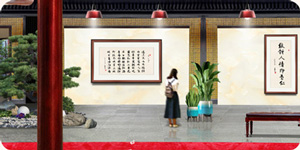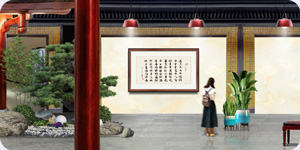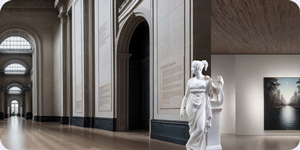创新线上数字展览虚拟数字展览实景VR展览大型展会快速上线策划 制作 推广
欢迎来到万度数展
体验不一样的线上数字展览!
万度数展是万度云科技(珠海)有限公司旗下的专业数字展览品牌,致力于线上数字展览技术的创新研发和应用。
我们提供多种创新的数字展示解决方案,包括全虚拟线上展览、多媒体全景VR线上展厅、大型展会快速转化成线上展、Web3D三维数字展览和产品互动演示等。
作为数字展览领域的创新者,我们拥有先进的技术和专业的团队,能够快速为您创建专业独特的数字展览。
通过灵活使用领先的虚拟现实(VR)、全景、Web3D、交互展示、信息化技术,我们的数字展览不仅提供逼真的展览场景和身临其境的体验,更加注重信息智能集成和提高内容的可读性。观众可以通过电脑、平板、手机、VR一体机等设备,随时随地参观线上展览,并与展品进行互动和探索。
无论您是艺术家、文化机构、博物馆、展览公司还是企业,我们的团队都期待与您合作,深入了解您的目标和品牌形象,提供量身定制的独特数字展览解决方案。
线上数字展览是未来展览的趋势,它不受时间和地点限制,能够提供更广阔的观众覆盖面。
选择万度数展,我们将与您一起打造一场全新的线上数字展览,提升品牌影响力。


虚拟线上数字展览
快速办展真实体验
万度数展提供多样的数字展厅选择,适合各种类型的书法、绘画、摄影、艺术品展览。我们提供线上展览的全流程服务,注重展览细节,提高作品的可读性。融合多种媒体元素,为观展者提供更多互动方式,使观展体验更加生动而丰富。

大型展会快速转化
完整上线同步开启
经过研发和实践,采取预制作和场景预搭建、快速采集和智能传输,实现了大型展览到线上展览的快速转化,在开幕时同步上线,并预先集成了展会和参展商的视频、语音解说、图文介绍、联系信息等,让展会突破时空同时实现展览内容的无限延伸。

实景展览数字展厅
多媒体互动VR呈现
线上全景VR数字展厅突破时空限制,大大提高了展览的传播范围和展示效果。万度数展利用无缝媒体植入和交互技术,能够把场景真实还原到线上,让所有媒体设备该动的都会动起来。同时提高内容的延伸和可读性,支持PICO,Meta等VR一体机操控和无线同屏演示。

Web3D艺术展览
多维产品互动演示
采用领先的web3D技术,实现在独特的艺术展厅中自由漫步,无缝媒体植入和交互技术让观众能够身临其境地参观展览。同时,展品与互动功能相结合,为观众提供更丰富的参观体验。
创新虚拟线上展览
更自然的观展体验

创新虚拟展览
专业快速办展
独特的虚拟展览技术为观众提供简单快捷的沉浸式艺术展览体验。观众可以通过电脑、手机或VR设备参观展览,无需受限于时间和地点,轻松欣赏艺术品。艺术家只需提供作品的照片或将作品快递给我们,万度数展的专业团队将负责剩下的展览策划和设计制作工作,确保展览的高质量和快速上线。

顶尖艺术殿堂
真实展厅体验
万度数展的线上虚拟展厅模拟了世界各大著名博物馆、美术馆、艺术馆、宫殿等的真实场景,为观众提供了在顶尖艺术殿堂欣赏艺术品的感受,让更多艺术家实现到心中的艺术圣殿举办作品展览的梦想,让作品得到更广泛的关注。高清的场景和逼真的光影效果,让一切看起来更为真实。

聚焦作品展示
品鉴精美细节
与实体展览一致的布展设计,专业视觉引导、流畅的展览体验,每一幅作品都可以点击放大查看细节,同时还可以弹出标签了解更多关于作品的信息。为书画作品提供精美的装裱,上千种边框可供选择,绿植、家具、摆件根据展览灵活搭配,在万度数展您可能无法找到完全一致的数字展厅,每一场展览都是定制。

多媒体多互动
分享价值变现
整合视频、语音讲解、动画、图文等各种媒体形式,观众可以通过分享、点赞、寻宝等互动环节参与展览,使整个展览场景更加生动有趣。支持作品链接到个人名片、官网、第三方售卖店铺等,为艺术家提供直接洽购或收藏的机会。观众可以通过点击作品,了解更多关于艺术家和作品的信息,并进行购买或收藏。
大型展会实景快速转化为线上展会

实景制作
真实体验
使用高清VR全景摄影将现场的场馆、展位、产品等完整克隆,让线上观众能够感受到与现场一致的视觉效果和空间感,真实的现场,每家企业精心搭建的展位,无需3D制作,降低成本和缩短制作周期。

线上线下
同步开启
预设计定制界面和交互,根据展会平面布局和展台效果图制作好完整的线上场景,预植入展会和展商信息,布展完工后现场快速采集上传,确保展会开幕前上线主体或全部场馆,请嘉宾见证,来客分享。

完整呈现
多重导览
模拟用户视角高密度布点采集,兴趣点全覆盖拍摄,将整个展会完整还原到线上,展板能高清放大,用户可通过平面导览图、精选展位、企业列表、企业搜索、3D场景多种导览形式引导快速精准访问。

信息互动
无限延伸
在场景中植入展位和每个展商的视频、解说、图文介绍、联系信息、官网链接等,以展会现场实景为载体拓展延伸参展企业信息,智能交互显示当前场景企业信息,多媒体融合,构建实景元宇宙。
多媒体互动VR展览
高科技展厅动起来

突破时空限制
传播范围更广
线上数字展厅不受地域和时间限制,用户随时随地参观,并分享给好友,大大提高了传播范围和展示效果,还能减少大量维护成本。

视频媒体交互
真实还原体验
万度数展利用无缝媒体植入和交互展示技术,将高科技现场真实还原到线上,同步解说、无缝视频、游戏交互、环境声效……提供更好的身临其境般体验。

内容高清好读
展品互动展示
所有展板、图文介绍采用分切式多分辨率缩放,加载快、无限高清放大。展品互动能能弹出介绍、查看细节、链接购买等,还可以通过Web3D三维植入,让用户在手里翻着看。

成本低用途广
快速积聚人气
数字展厅制作成本低,能通过网络传播分享、支持各种终端设备,能部署在展厅、活动现场等有需要地方,快速搭建数字分馆,通过大屏展示、触屏体验、VR互动等快速吸引观众参与,积聚人气。
专业的事情交给我们
每场展览都量身定制
文案设计
提供全流程的线上数字展览服务,提供展览策划,撰写文案,设计独特的分享海报……
数字展厅
世办著名的博物馆和展厅实地取景或者高精度模型渲染搭建的虚拟展厅,中式、欧式、现代、古老、简约、奢华……各种风格自由选择。
作品装裱
提供数百款不同风格的相框选择、还可以给书法作品更换背景纸张,逼真的光影效果,让一切看起来更加真实。
绿植饰品
绿色植物、工艺品摆设、展柜、陈列架……品种、款式丰富,休息椅都有几十款选择,在万度数展您可能永远找不到完全一样的展厅。
无需自己动手,有专业的策划、文案、设计师为您办展!
您只需与我们沟通:13823062396 0756-6163098




















